Millions of Americans are unaware of a silent struggle in their bodies. Insulin resistance affects nearly 40% of adults in the United States. Yet, most people find out too late, after serious health problems arise.
The old way of finding out requires many doctor visits and lab tests. But now, there’s a better way. Insulin resistance test at home gives accurate results without the need for appointments or time off work.
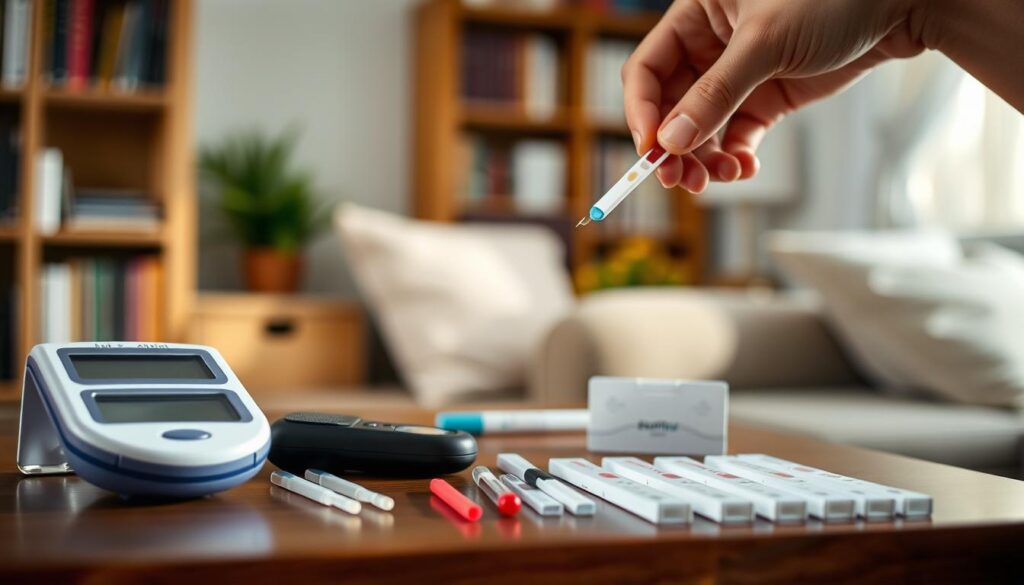
I’ve created a completely FREE guide, easy to understand, just for you. Inside, you’ll discover:
- Simple, science-backed daily routines that improve sugar level in your blood.
- Natural nutrition tips to support blood sugar levels.
My top product recommendations — carefully selected to truly help you.
Early detection is key to preventing diabetes and other metabolic disorders. By regularly checking their blood sugar levels, people can act early. This helps avoid worse conditions.
These easy tests let people check their metabolic health from home. It’s simple, fast, and gives results that doctors trust.
Key Takeaways
- Nearly 40% of American adults have insulin resistance, often without symptoms
- At-home testing eliminates the need for multiple doctor visits and lab appointments
- Early detection of blood sugar issues prevents progression to serious diabetes complications
- Modern home testing methods provide accurate, reliable results that healthcare providers accept
- Regular monitoring allows people to take preventive action before conditions worsen
- The testing process is simple, fast, and can be completed in the comfort of your home
Understanding Insulin Resistance and Its Health Impact
When cells don’t respond well to insulin, it’s called metabolic dysfunction. This makes it hard for the body to control blood sugar levels. Insulin resistance can lead to serious health problems if not treated.
The body’s glucose system relies on insulin and cell receptors working together. If this fails, people face higher risks of metabolic disorders. Knowing the signs helps prevent these issues.
What Is Insulin Resistance and How It Affects Blood Sugar
Insulin resistance happens when cells don’t listen to insulin signals. Insulin is like a key that lets glucose into cells. But when cells resist, glucose stays in the blood.
The pancreas makes more insulin to try and lower blood sugar. But this makes cells even more resistant. So, high blood sugar levels keep rising.
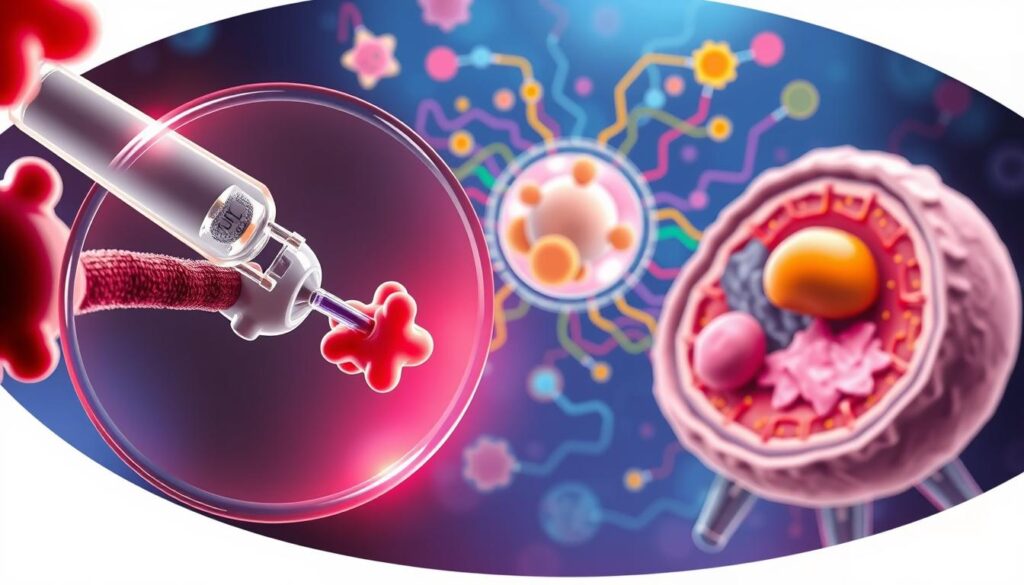
Many things can make cells resistant to insulin. Too much belly fat, not enough exercise, and stress all play a part. Stress hormones like cortisol make insulin less effective.
The liver also plays a big role in insulin resistance. It keeps making glucose even when blood sugar is high. This makes it hard to keep blood sugar levels normal.
The Connection Between Insulin Resistance and Type 2 Diabetes
Insulin resistance is the main cause of type 2 diabetes. It takes years for the pancreas to fail to make enough insulin. At first, the body makes more insulin to keep blood sugar normal.
But as insulin resistance gets worse, the pancreas can’t keep up. Beta cells that make insulin start to die. This leads to high blood sugar levels, a hallmark of diabetes.
About 90% of people with type 2 diabetes have insulin resistance. It often comes with other health problems like high blood pressure and high cholesterol. This group of symptoms is called metabolic syndrome.
Preventing diabetes starts with improving insulin sensitivity. Losing weight, exercising regularly, and eating right can help. Early action is key when you’re at risk.
Recognizing Symptoms of Insulin Resistance Early
Insulin resistance symptoms start slowly and can be mistaken for aging or stress. Feeling very tired, especially after eating, is a common sign. This is because cells can’t get glucose for energy.
Craving carbs and feeling hungry all the time shows the body’s struggle to keep blood sugar stable. Energy crashes between meals are common. This leads to overeating and weight gain.
Dark skin patches, or acanthosis nigricans, can appear on the neck, armpits, or groin. This skin issue is linked to insulin resistance. Also, finding it hard to lose weight is a sign of metabolic problems.
Brain fog and memory issues can happen too. The brain needs steady glucose to work well. Insulin resistance messes with this, causing mood swings and stress.
Women might have irregular periods or trouble getting pregnant due to insulin resistance. Men might feel less energetic and gain belly fat.
Why Testing for Insulin Resistance Is Critical for Your Health
Testing for insulin resistance is more than just checking blood sugar. It’s about protecting your health fully. Many people don’t know that insulin resistance can lead to serious health issues. Early testing can stop these problems before they start.
Knowing why insulin resistance testing is important helps you make better health choices. It affects millions of Americans, putting them at risk for heart disease and diabetes.
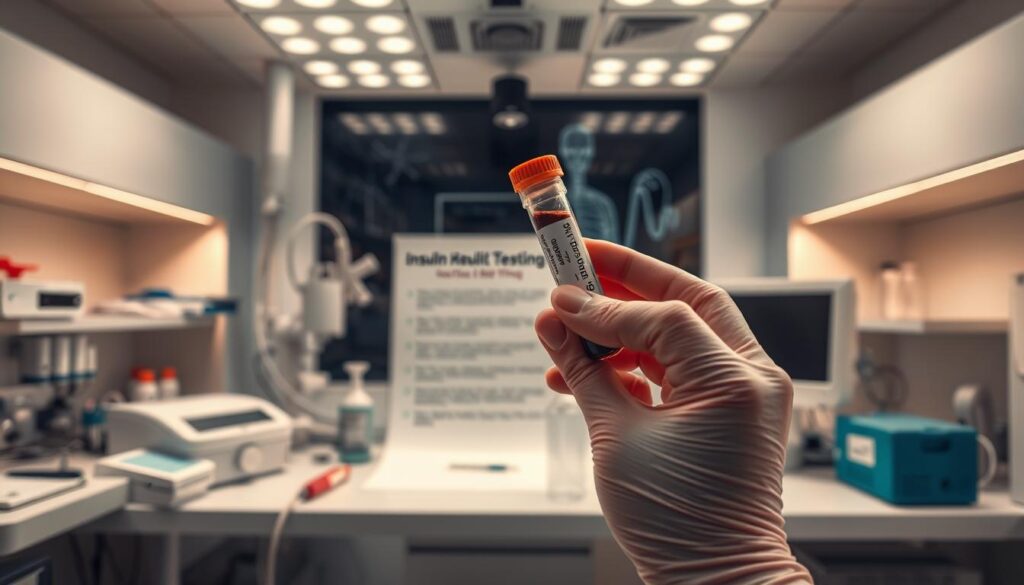
Health Risks of Undiagnosed Insulin Resistance and Metabolic Syndrome
Not knowing you have insulin resistance can lead to metabolic syndrome. This includes high blood sugar, high blood pressure, and bad cholesterol. These factors increase the risk of heart disease and diabetes.
Insulin resistance can turn into metabolic syndrome over time. Your body struggles to control blood sugar as cells become less responsive. Without action, your pancreas makes more insulin.
Untreated insulin resistance raises your risk of heart problems. It also causes inflammation, damaging blood vessels and organs. Plus, it can make you gain weight, especially around your waist.
Learn how to take back control of your blood sugar level.
How High Blood Pressure and Cholesterol Levels Connect to Insulin Resistance
Insulin resistance, high blood pressure, and bad cholesterol are linked. When cells don’t respond to insulin, your body makes more insulin. This can make your blood vessels hold sodium and narrow, raising blood pressure.
Insulin resistance also messes with fat processing. This leads to more triglycerides and LDL cholesterol and less HDL cholesterol. These changes increase your risk of heart disease.
Fixing insulin resistance can help with blood pressure and cholesterol too. This is why testing for insulin resistance is key to heart health.
Benefits of Early Detection and Intervention
Finding insulin resistance early has many benefits. Early detection lets you make lifestyle changes to improve insulin sensitivity. These include eating right, exercising, and managing your weight.
Testing for insulin resistance helps doctors create treatment plans early. Studies show that early lifestyle changes can cut diabetes risk by up to 58%. This is better than treating diabetes later.
Early action also prevents heart problems. By tackling insulin resistance quickly, you avoid heart disease and stroke. Regular checks help adjust treatment plans for the best results.
Knowing you have insulin resistance also helps your mental health. It gives you peace of mind and lets you take charge of your health. This knowledge helps you make better choices for a healthier life.
Traditional Laboratory Tests vs Home Testing Options
Insulin resistance testing has changed a lot with at-home tests. Both lab tests and home tests have their benefits. Knowing the differences helps people pick the best test for them.
Doctors usually suggest lab tests for first checks and detailed tests. But, home tests are great for keeping an eye on health over time. The choice depends on how accurate you need the test, how easy it is to use, and how much it costs.
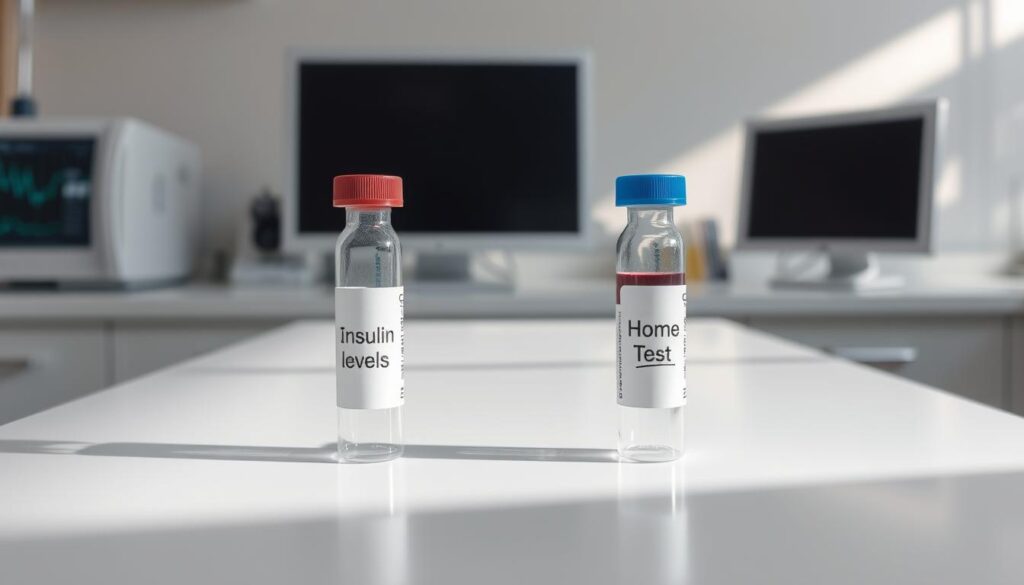
Standard Blood Test Methods for Measuring Insulin Levels
Labs use special machines and strict methods to measure insulin levels accurately. Trained staff take blood samples in a controlled setting. They use advanced tests to get exact fasting insulin levels.
Tests happen in the morning after not eating for 8-12 hours. This ensures the test shows the right insulin and glucose levels.
Labs follow strict rules to keep results consistent. This means doctors can trust the results to diagnose and treat insulin resistance.
Fasting Glucose and Glucose Tolerance Test Procedures
The fasting glucose test checks blood sugar after not eating for at least 8 hours. It shows how well the body handles glucose without food. Normal levels are between 70-99 mg/dL.
A glucose tolerance test takes blood at different times over hours. First, a fasting sample is taken, and then a sugar drink is given. More blood samples are taken at 1 and 2 hours to see how fast blood sugar goes back to normal.
This test needs fasting and staying at the test site for up to three hours. It shows how the body handles glucose fully. This helps find diabetes and prediabetes.
Advantages and Limitations of At-Home Testing
At-home testing is easy to use for checking blood glucose often. You can test anytime without going to a doctor. This helps manage diabetes better and catch changes early.
Home tests are pretty accurate if used correctly. Many connect to apps on phones to track and spot trends. But, they might not be as precise as lab tests, especially for fasting insulin levels.
Home tests are cheaper for daily use. They cost more upfront but save money in the long run. Check insurance before choosing a test.
The biggest drawback of home tests is the chance for mistakes. Proper training and keeping devices calibrated helps. Still, doctors often recommend lab tests for accurate results, especially for serious cases.
Insulin Resistance Test at Home: Methods and Accuracy
At-home test kits make it easy to check blood glucose levels and spot insulin resistance. They are popular because they are easy to use and give accurate results. This way, people can keep an eye on their health without always going to the doctor.
The accuracy of these tests has gotten much better. Most kits now give results as good as lab tests. But, it’s important to know how they work and their limits to monitor health well.
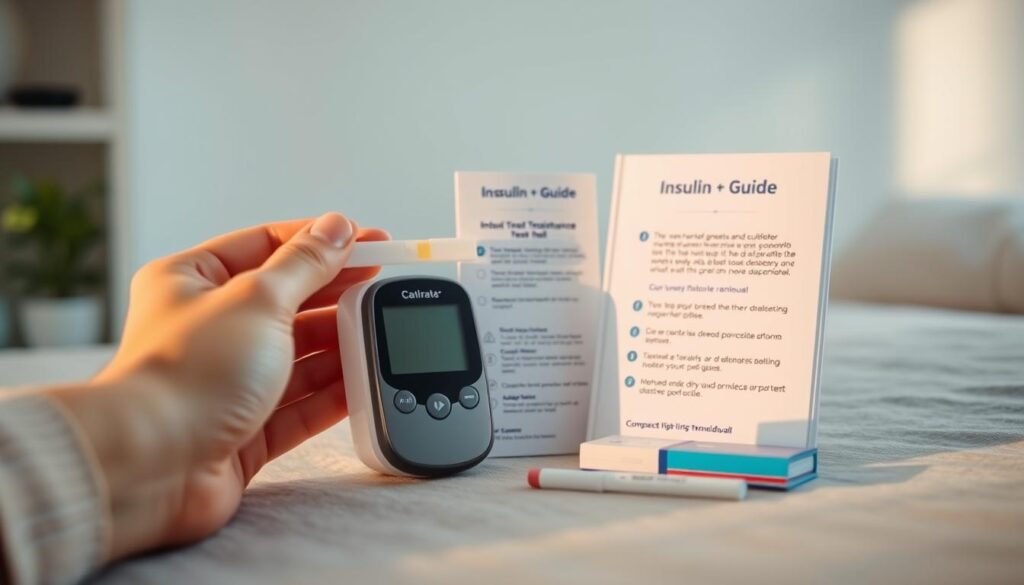
Available At-Home Test Kits for Blood Glucose Levels
Many trusted brands offer insulin resistance test at-home solutions. These kits usually have glucose meters, test strips, and lancets for blood samples. Brands like Accu-Chek, OneTouch, and Contour Next are well-known.
Each kit has different features and levels of accuracy. Some can connect to smartphones for tracking. Others have big displays for easier reading. Advanced kits might also test for ketones.
When picking a kit, think about the cost of strips, insurance coverage, and how easy it is to use. Most kits need just a small blood sample from your finger. The results usually come up in under 10 seconds.
| Test Kit Brand | Accuracy Rating | Key Features | Average Cost |
|---|---|---|---|
| Accu-Chek Guide | ±10% accuracy | Smartphone app, spill-resistant strips | $25-35 |
| OneTouch Ultra 2 | ±15% accuracy | Large display, fast results | $20-30 |
| Contour Next | ±8.4% accuracy | Second-chance sampling, no coding | $30-40 |
| FreeStyle Lite | ±12% accuracy | Small blood sample, 14-day average | $15-25 |
Fasting Insulin and Blood Sugar Level Testing Options
To test fasting insulin at home, you need to prepare and time it right. You must fast for 8-12 hours before taking the blood sample. This helps get a baseline insulin level without food affecting it.
The fasting blood glucose test checks how well your body handles blood sugar levels without food. Normal levels are between 70-99 mg/dL. Levels between 100-125 mg/dL suggest a risk of prediabetes.
Some home kits can measure both glucose and insulin at the same time. These tests give more detailed insights into insulin resistance. But, insulin-specific testing often needs special equipment or lab analysis.
Getting the timing right is key for accurate tests. Morning tests usually give the best results. Stress, illness, and medicines can change blood glucose levels, so it’s important to test consistently.
Understanding Your Test Results and Blood Glucose Levels
It’s important to know what your test results mean. Levels above 126 mg/dL on multiple tests might mean diabetes. Random tests over 200 mg/dL also show diabetes risk.
Testing after meals gives more insight into insulin function. Normal levels should be below 140 mg/dL two hours after eating. If levels stay high, it could mean insulin resistance is developing.
Watching your levels over time is more important than single test results. Testing weekly or bi-weekly helps spot trends in blood glucose levels. Many people find keeping a testing log helpful for talking to their doctors.
Take control of your health today by starting regular at-home glucose monitoring. Catching insulin resistance early can prevent serious problems and improve your health in the long run.
Many things can affect test accuracy and what they mean. Dehydration, extreme temperatures, and old test strips can skew results. Always follow the instructions and store your supplies right to keep your tests accurate.
If insulin levels stay high, you need a doctor’s check-up. Home tests are great for screening, but they can’t replace a full medical check-up. Doctors can order more tests like HbA1c or glucose tolerance tests for a full look at your health.
Preparing for Your At-Home Blood Test
To get accurate results from an at-home blood test, you need to prepare well. Knowing how to prepare helps you get reliable readings. This knowledge is key to understanding your health better.
Fasting Requirements and Pre-Test Preparation
Most blood glucose tests need you to fast for 8 to 12 hours before. You should only drink plain water during this time. This fasting helps your blood sugar levels stabilize.
The best time to take the test is in the morning after fasting overnight. This way, you get accurate results without disrupting your day. Testing at the same time every day makes your results more reliable.
To stay comfortable while fasting, try these tips:
- Drink lots of plain water to stay hydrated
- Test in the morning to avoid discomfort
- Avoid hard activities that make you hungry
- Have your testing materials ready the night before
Factors That Can Affect Your Blood Sugar Level Results
Many things can change your blood sugar readings. Medications are a big factor. Some medicines, like steroids and blood pressure drugs, can raise your glucose levels.
Stress also plays a big role. Both physical and emotional stress can increase your blood sugar. Recent illness, bad sleep, and intense exercise can also affect your results.
Other things that might change your readings include:
- Drinking alcohol in the last 24 hours
- Extreme temperatures affecting test strips
- Using expired or stored wrong testing materials
- Not drinking enough water or drinking too much caffeine
When to Follow Up with Professional Diabetes Screening
If your test results show high blood sugar, see a doctor right away. Fasting blood glucose levels above 126 mg/dL on several tests means you might have diabetes.
High random blood sugar levels, over 200 mg/dL, with diabetes symptoms need quick doctor’s care. Symptoms include too much thirst, needing to pee a lot, and losing weight without trying.
Even if your readings are not high enough to be diagnosed, seeing a doctor for a full check-up is a good idea.
See a doctor if you keep getting high readings, have symptoms of high or low blood sugar, have a family history of diabetes, or are unsure about your results.
Take action today by talking to your doctor if your at-home test shows worrying patterns or values.
Ready to take control of your blood sugar level?
Understanding Homa IR Test Results
Testing for insulin resistance at home is a big step in managing health. It lets people check their blood sugar and find issues early. This can stop serious problems like diabetes before they start.
Home testing makes it easy to keep an eye on health. It removes excuses for not checking health often. Now, busy lives and limited access to healthcare don’t stop people from getting tested.
Early detection is key. It means people can get help sooner. This can stop or slow down type 2 diabetes.
But, home tests are just the start. They work best with a doctor’s advice. Doctors help make sense of the results and suggest the right actions.
Doctors guide on what to do next. They might suggest changes in diet or exercise. Or, they might recommend medical treatments.
Checking blood sugar regularly helps people make better choices. It’s about eating right, exercising, and living a healthy lifestyle. This can greatly improve health and reduce the risks of serious problems.
By taking control of their health, people can live better lives. This is especially true for those at risk for insulin resistance.
